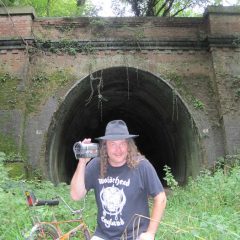Description
Opened in 1865, closed in 1964 and explored by Dumpman Films in 2018.
A detailed trek across much of the disused track bed between Kimbridge Junction and Andover Junction station. Sometimes travelling on foot, occasionally by car, but mostly on a vintage Raleigh Chopper, always searching for the remains of the great industry that was the railway. This film recreates the journey that used to be possible by train.
Starting at Kimbridge Junction, the layout of the junction is speculated upon before following the track bed on foot, spotting a variety of remaining artefacts and heading towards Mottisfont station. With kind permission from the owners, a thorough look at Mottisfont station ensues. The track bed is then re-joined slightly further north and travelled by bike to Horsebridge station.
Horsebridge station is the jewel in the crown of this line and has been beautifully preserved as a wedding venue and so numerous shots are taken to see this in all its glory.Continuing on the bike, the track bed is followed towards Stockbridge, spotting further artefacts and remains and views that travellers would have seen across the Test Valley.On reaching Stockbridge, the camera is mounted on the roof of the car to follow the course of the track now covered by road. Just north of Stockbridge, the bike is used again to make the journey to Fullerton Junction, with further railway related remnants revealed en route.After a good look around Fullerton Junction, including the Hurstbourne platforms, a short section of track is followed to the north before a deviation around a private area used for shooting. The track is rejoined briefly on foot alongside Westover Farm, with views from the side of the track taken on the way to Clatford. Leading in to Clatford, a riverside section of track bed is viewed near a filled in underbridge, before arriving at the site of Clatford station. The station site is examined thoroughly for all remaining clues. Slightly further north, a sizeable overbridge is used to view the track through private land.
At Water Lane, the site of Upper Clatford siding is viewed, before getting back on the bike for the last time to travel towards Andover. Travelling under the current A303, a tarmac cycle path runs along the track bed to the site of Andover Town station. The layout of the station is speculated upon, before mounting the camera on the roof of the car for the final time to travel the remaining section of track towards Andover Junction station.
A short section of embankment occupied by Travis Perkins is viewed before entering Andover Junction station and seeing it from a variety of angles, including the disused platform that used to serve the Sprat and Winkle line.
A detailed trek across a vintage map follows, picking out locations of points of interest that have been seen in the main body of the film, followed by a slide show of stills taken at the time of filming.
Running time: 3 hours (3 x dvds). Price: £12
ALTON TO BASINGSTOKE DISUSED RAILWAY TRACK BED TOUR DVD 2019
Dumpman Films reveals the charms of another, well-loved and short-lived rural railway.
This unique line is probably more famous for activities that took place on it after closure than anything that came before, playing host to the 1937 Will Hay film, Oh ! Mr Porter ! It had also been used for the most spectacular staged train crash in British cinematic history when The Wrecker was filmed on it in 1928.
Opening in 1901, closing in 1916, opening again in 1924 and finally closing to passengers for good in 1932, its passenger carrying only lasted 31 years. A classic rural line with tin shack stations, built miles from the tiny communities they were supposed to serve and operated by an often reluctant railway company, the odds were stacked against its success.
Despite this, there is an enduring interest in specific sections of the line from film fanatics and railway hunters alike, both groups making regular pilgrimages.
The aim of this film was to travel the track bed as faithfully as possible on foot, by bike and in a couple of instances by car where the track has had road built over it. Numerous land owner sanctioned visits allow views that are not normally easy to obtain.
Starting at the southern end at Alton station, views showing the interaction between the National Rail Network, the preserved Watercress Line, the Meon Valley Line and the line to Basingstoke begin the film.
This is swiftly followed by a visit to the overgrown, remaining platform at Alton Park and the capstan operated, Lord Mayor Treloar Hospital siding, with the capstan still in place. A view of a short section of commemorative track and a plaque are seen in the hospital grounds before moving on.
Track bed is then travelled on foot while offering historical commentary, nearly all the way to Bentworth and Lasham station site, missing only the occasional ploughed or sown field.
A small section of remaining visible platform is viewed at Bentworth and Lasham, with wider views showing the station master’s house and railway cottages.
A section of track bed covered by the A339 is then travelled, with the camera attached to the roof of a car (the Polocam), before reaching the base of Lasham Hill. This is where the site of the spectacular train crash for the film The Wrecker was staged in 1928 and the exact point of impact is pinpointed in this film.
Further track bed is then walked, through various copses, before reaching Herriard station. Here the platforms are admired, along with views of the station master’s house and railway cottages. Also spotted are the ruins of the base of the well and water tower.
Track bed is followed again on foot, through some of the most attractive scenery on the line, spotting remains of cattle grids not removed by the demolition contractors and taking in some of the fine Hampshire countryside views that passengers would have had all those years ago.
Immediately next to the largest remaining embankment on the line at Winslade, is the tiny, disused, non-conformist chapel, which pre-dates the railway and ceased to be used as a place of worship in 1930. After taking in views of this and the solidly built accommodation tunnel under the embankment, your cameraman hops on his battered old Raleigh Chopper to travel the steep descent to Swallick Farm, before further walking is required alongside heavily overgrown track bed.
The next stop is at Cliddesden station, where unrestricted access offered by the resident owner allowed views of the key areas, where the Will Hay film Oh ! Mr Porter ! was shot in the summer of 1937. The station master’s house, railway cottages, base of the water tower and remains of the siding area loading platform are seen, before showing the alignment of the platform. The position of the signal box (constructed by the film company solely for Oh ! Mr Porter !) is shown, as are the huge horse chestnut trees which appeared as saplings on the platform in the film, 82 years earlier.
Further travel on foot takes the viewer to the eastern edge of the village of Cliddesden, where a missing bridge and a house called “Railways” marks the spot that the villagers had wanted their short-lived station to be situated. A long lens view of the track bed is shown, where the construction of the M3 motorway cut through the track bed in 1971.
Moving to the north of the M3, various “green lanes” of track bed are shown, running through the southern industrial area of Basingstoke, known as Viables. A commemorative plaque and section of track is seen at Viables roundabout, before following the course of the track through the Cranbourne Lane area and towards the western Basingstoke ring-road.
On reaching the point where the track would have met the ring road, a second stretch of road is travelled with the Polocam, passing the site of the Thorneycroft works and arriving at the last remaining section of track still in place, next to Basingstoke Waterworks.
A brief train ride from Basingstoke to Micheldever provides a fleeting opportunity to the view the northern end of the remaining stub of track, before finishing the journey on the disused platform at Basingstoke station.
Includes constant, well-informed commentary, reference to a vintage map and a slide show of stills taken during filming.



Reviews
There are no reviews yet.